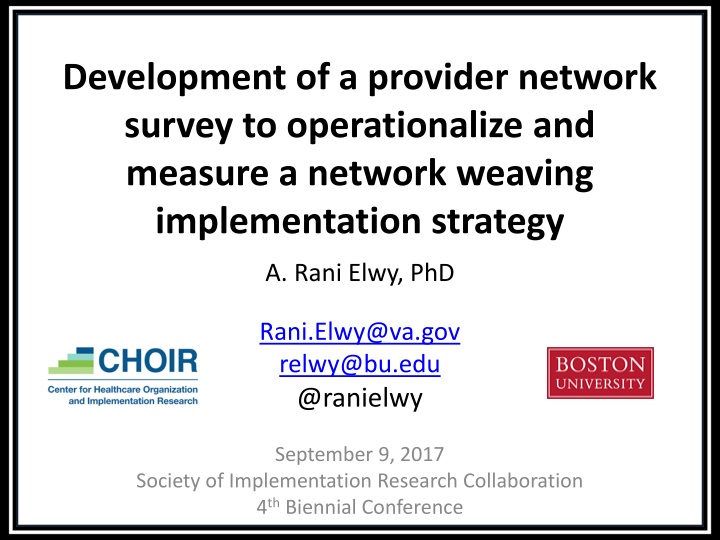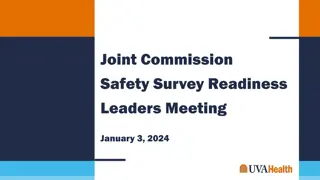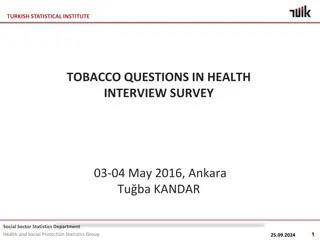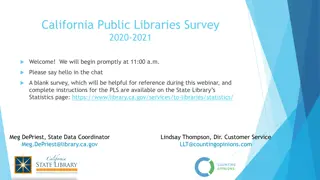
Provider Network Survey for Network Weaving Implementation Strategy
This content discusses the development of a provider network survey aimed at operationalizing and measuring a network weaving implementation strategy. It also explores the hybrid approach in a research study focusing on mental health providers and communication connections within organizations. Strategies such as promoting network weaving and theories like the diffusion of innovations are highlighted to enhance collaborative problem-solving and information sharing. The content also outlines the aims and characteristics of the Hybrid I process evaluation, shedding light on the effectiveness of clinical interventions and implementation strategies.
Download Presentation

Please find below an Image/Link to download the presentation.
The content on the website is provided AS IS for your information and personal use only. It may not be sold, licensed, or shared on other websites without obtaining consent from the author. If you encounter any issues during the download, it is possible that the publisher has removed the file from their server.
You are allowed to download the files provided on this website for personal or commercial use, subject to the condition that they are used lawfully. All files are the property of their respective owners.
The content on the website is provided AS IS for your information and personal use only. It may not be sold, licensed, or shared on other websites without obtaining consent from the author.
E N D
Presentation Transcript
Development of a provider network survey to operationalize and measure a network weaving implementation strategy A. Rani Elwy, PhD Rani.Elwy@va.gov relwy@bu.edu @ranielwy September 9, 2017 Society of Implementation Research Collaboration 4thBiennial Conference
Hybrid I added to an ongoing RCT to test effectiveness of Mantram Meditation vs. Present-Centered Therapy for military-related PTSD
Promote Network Weaving Identify and build on existing high-quality working relationships within an organization to promote information sharing, collaborative problem-solving, and shared goals related to an implementation. Powell BJ, Waltz TJ, Chinman MJ, Damschroder LJ, Smith JL, Matthieu MM, Proctor EK, Kirchner JE. A refined compilation of implementation strategies: results from the Expert Recommendations for Implementing Change (ERIC) project. Implement Sci. 2015 Feb 12;10:21.
Theory of Diffusion of Innovations Key features of the innovation for adoption include: a perceived relative advantage, compatible with perceived needs, values and norms, low complexity, amenable to being tested out on a limited basis, benefits are observable, and potential for reinvention or adaption to local circumstances PEER-TO-PEER CONVERSATIONS TRUST
Aims of Hybrid I Process Evaluation 1. Develop and evaluate a social network survey to assess mental health providers connections and communication 2. Further explore these through semi- structured interviews with a subset of these providers
Study Characteristic Research aims Hybrid Trial Type 1 Primary aim: determine effectiveness of a clinical intervention Secondary aim: better understand context for implementation Hybrid Trial Type 2 Coprimary aim*: determine effectiveness of a clinical intervention Coprimary aim: determine feasibility and potential utility of an implementation intervention/strategy Hybrid Trial Type 3 Primary aim: determine utility of an implementation intervention/strategy Secondary aim: assess clinical outcomes associated with implementation trial Evaluation methods Primary aim: quantitative, summative Secondary aim: mixed methods, qualitative, process-oriented, could also inform interpretation of primary aim findings Clinical effectiveness aim: quantitative, summative Implementation aim: mixed method; quantitative, qualitative; formative and summative Primary aim: mixed-method, quantitative, qualitative, formative, and summative Secondary aim: quantitative, summative Measures Primary aim: patient symptoms and functioning, possibly cost Secondary aim: feasibility and acceptability of implementing clinical treatment, sustainability potential, barriers and facilitators to implementation Clinical effectiveness aim: patient symptoms and functioning, possibly cost effectiveness Implementation aim: adoption of clinical treatment and fidelity to it, as well as related factors Primary aim: adoption of clinical treatment and fidelity to it, as well as related factors Secondary aim: patient symptoms, functioning, services use Part of Table 3 in Curran GM, Bauer M, Mittman B, Pyne JM, Stetler C. Med Care. 2012; 50(3):217-26.
Hypotheses 1. Providers who referred Veteran patients to the RCT cluster together (are central )in their social network compared to providers who did not refer to the RCT 2. Providers who referred Veteran patients to the RCT serve as bridgers in their social networks people who have influence across multiple social networks compared to providers who did not refer to the RCT.
Social Network Survey Three bounded networks (potentially based on trust): Which colleagues do you speak to regularly at work (Q2) Which colleagues opinions on new clinical treatments do you rely on the most? (Q3) Which colleagues do you go to when you need help managing a complex clinical situation at work? (Q4) Independent Variables: Social network centrality variables (6) Dependent Variable: Referred to study (0 or 1) Logistic Regression analyses using R; maps created in Gephi N=69 (53% response rate)
Social Network Variables 1. Indegree centrality- number of individuals designating participant 2. Outdegree centrality- number of individuals participant designates 3. Incloseness centrality- average number of steps from individuals to participants 4. Outcloseness centrality- average number of steps from participant to individuals 5. Betweeness centrality- number of shortest paths going through participant 6. Eigenvector centrality- greater if participant connected to other highly connected individuals
Logistic regression summary table of centrality variables predicting referral behavior Model w/out closeness & eigenvector & betweenness centralities Q2 network: Which colleagues do you speak to regularly at work? Significant variable OR 95% CI Pr(>|z|) indegree centrality 1.25 1.00, 1.60 0.0569 Q3 network: Which colleagues opinions on new clinical treatments do you rely on the most? indegree centrality 1.37 1.10, 1.84 0.0177 Q4 network: Which colleagues do you go to when you need help managing a complex clinical situation at work? indegree centrality 1.27 1.03, 1.59 0.0268 indegree centrality: the number of individuals in the network who designated the participant
Q2: Which colleagues do you speak to regularly at work? Larger circles indicate provider referred patient to the RCT. Color of edge indicates its source node.
Bridging Data Betweenness centrality was highly correlated with eigenvector centrality (r=0.63), followed by outdegree (r=0.61) and outcloseness (r=0.60) Individuals who are connected to other highly connected individuals, those who speak to others most, and those who are the smallest number of steps away to others are the most likely to serve as bridges between particular provider cliques
Q3: Which colleagues opinions on new clinical treatments do you rely on the most? Larger circles indicate provider referred patient to the RCT. Color of edge indicates its source node.
Bridging Data Betweenness centrality shows the highest correlation with eigenvector centrality (r=0.64), followed by outdegree centrality (r=0.57) Individuals who are connected to other highly connected individuals, and those who seek others most for opinions on new clinical treatments are most likely to serve as bridges between provider subgroups, or cliques
Q4: Which colleagues do you go to when you need help managing a complex clinical situation at work? Larger circles indicate provider referred patient to the RCT. Color of edge indicates its source node.
Bridging Data Betweenness centrality was highly correlated with eigenvector centrality (r=0.75), followed by indegree (r=0.70) Individuals who are connected to other highly connected individuals, and those who are sought by others most for help in managing complex clinical situations are the most likely to serve as bridgers between particular provider subgroups, or cliques.
Qualitative Study (N=12) 25 (36%) providers were willing to participate in an additional face-to-face interview Constant comparative method (part of grounded theory), until saturation was reached in interview findings Line-by-line coding, and then individual codes were discussed until consensus was reached Coding frame was established through this process, refined throughout our analyses Once all codes were identified and defined, began to collapse codes into overall themes
Believing in Ones Own Clinical Judgment If I learned a structured treatment it would mean sacrificing my own clinical judgment Sometimes the information that providers need comes from observing other providers using this treatment at work when clinicians see that it works, and they are willing to learn it s a slow process, and it takes time to change change is always better. It allows us to move from the Dark Ages to the modern, because we know that what we ve been doing isn t working
Idealism of Evidence-Based Practices Participating in EBP training is above and beyond your job description but if you are told by leadership to attend training , a provider will do it Having clinical training or experiences outside of the VA often helped providers gain exposure to EBPs in these other settings, and now these providers were viewed as having something to add to the clinical toolbox , which they could share with others
Deliberately Manufacturing Time for Conversations (1) Conversations about EBPs and other clinical treatments are not interwoven into the system yet in a way that is helpful for change . Could involve having lunch, even though you know that you ll have to stay late to write your clinical notes, but doing this once a month or so is worth it .
Deliberately Manufacturing Time for Conversations (2) Talking to colleagues socially outside of work, and even walking to a colleague s car after work, in order to have ten minutes outside of the car to talk was how sneaking time for these conversations could occur. Importance of trust in these conversations, with one stating there s [sic] a few people who I really trust, so if certain people mention [a clinical treatment], I take that very seriously .
Conclusions (1) Evidence for Hypothesis 1: Providers with high indegree centrality were significantly more likely to refer patients to the RCT than those providers with lower indegree centrality Evidence for Hypothesis 2: Providers who referred Veteran patients to the RCT serve as bridgers in their social networks, compared to providers who did not refer to the RCT Betweeness centrality was highly correlated to eigenvector centrality in all three social networks; indegree centrality highly correlated with both Those connected to other highly connected mental health providers were likely to serve as bridges between these particular provider cliques
Conclusions (2) A social network survey of mental health providers helped to identify highly influential individuals, some of whom may not have a formalized leadership position within a department or organization, and therefore, would not necessarily be selected to be a champion or opinion leader in the setting of an implementation trial To promote network weaving , need to use survey in prospective design
Limitations A retrospective analysis to predict providers referral behaviors Study was conducted at one site Used only centrality measures to obtain bridging metrics; specific bridging measures have been identified and tested
Translating Research into Practice Generalizable Practice Implications Promoting the use of evidence in providers clinical decision making through more frequent conversations with others who are highly trusted and who promote this use of evidence, should be a priority for any clinical leader/administrator Practice Implications for VA mental health leaders Need for in-person contact between providers in order to discuss the merits of an EBP with a trusted colleague Colleagues who have high indegree centrality, in addition to being trustworthy, may also be more accessible to others, or more willing to provide their time to others use them!
Acknowledgements National Institute of Mental Health (R25 MH080916-01A2), and the Department of Veterans Affairs, Health Services Research and Development Service, Quality Enhancement Research Initiative
Thank You to Collaborators Bo Kim, PhD Dorothy Plumb, MA Shihwe Wang, PhD Allen Gifford, MD Steven Asch, MD, MPH Jill Bormann, PhD, RN Brian Mittman, PhD Tom Valente, PhD Larry Palinkas, PhD Elwy AR, Kim B, Plumb DN, Wang S, Gifford AL, Asch SM, Bormann JE, Mittman B, Valente TW, Palinkas L. Development of a social network implementation strategy: a mixed methods study. Under review.






















